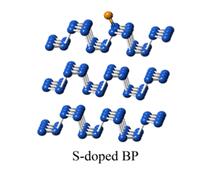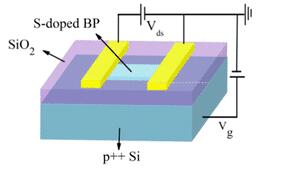As one of the newest member of 2D nanomaterials, black phosphorus (BP) has a puckered layered structure with a tunable direct band gap ranging from ~0.3 eV for bulk to ~2 eV for monolayer. The tunable direct bandgap on thickness gives BP promising applications in extensive field such as energy storage areas (lithium/sodium ion battery, thermoelectric devices and supercapacitors), gas sensor, humidity sensor, biomedicine field and memory devices, etc. However, its instability under ambient conditions poses challenge to the research and limits its practical applications. A research team led by Prof. ZENG zhongming from Suzhou Institute of Nano-tech and Nano-bionics of the Chinese Academy of Sciences and cooperator Prof. Liu zhongyuan from State Key Laboratory of Metastable Materials Science and Technology of Yanshan University proposed a new strategy to enhance the stability of black phosphorus by Sulfur doping. The S-doped BP was prepared by the method of high-pressure and high-temperature. The stability of S-doped BP were investigated by continuously measuring the field-effect transistors (FETs) performances and characterizing the morphology change using atomic force microscope (AFM) under ambient conditions. The charge-carrier mobility remained ~ 77% as the initial value and a high Ion/Ioff ratio of ~103 under ambient for 21 days. The surface morphology variation confirmed that the degradation of S-doped BP was effectively suppressed. The first-principles calculations reveals that the dopant S atom energetically prefers to chemisorb on the BP surface in a dangling form. The conduction band minimum (CBM) of S-doped BP with respect to vacuum energy shift below the redox potential of O2/O2-. This can effectively suppress the oxidation process of BP. Their work entitled “Sulfur-doped black phosphorus field-effect transistors with enhanced stability” was published in ACS Applied Materials & Interfaces. This research was supported by the National Natural Science Foundation of China. 
Simulation cell configuration of trilayer S-doped BP.(Image by SINANO) 
Schematic of device structure of few-layer S-doped BP FETs.(Image by SINANO) (Information Source: SINANO) |

